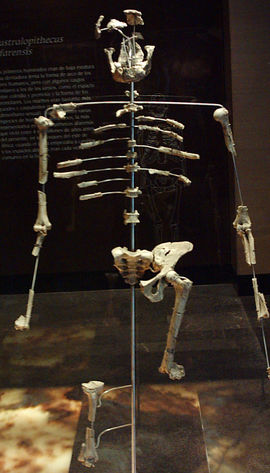Lucy Fails Test As Missing Link
By
Editorial Staff
Published December 2007
The science of finding and identifying man’s “prehistoric ancestors” runs in a predictable pattern. A press conference is announced, the discovery of an ape-like “ancestor” revealed with an artist’s impression of what the creature looks like, and the discoverer becomes famous, earning money on lecture tours. The actual fossil bones are scanty and the imagination runs wild. Later, when more evidence is found, the “ancestor” turns out to be totally human or totally ape. The Neanderthal man is an example of one find that turns out to be totally human. Once this find is removed as an intermediate form, you can expect another great discovery to save the day. The latest discovery is “Lucy.”
If you are of the impression that there are many intermediate ancestors to man, take notice of the following statement by an expert in the field: “The fossils that decorate our family tree are so scarce that there are still more scientists than specimens. The remarkable fact is that all the physical evidence we have for human evolution can still be placed with room to spare inside a single coffin.“1
This is still an exaggeration since it concedes that various specimens are part of human evolution. Australopithecines, for example, are not considered transitional forms anymore, but a branch of the primate evolutionary tree. True transitional forms are still missing. (“Transitional forms” refer to those creatures which represent intermediate states of development for a supposed ape-like ancestor down to man.)
But what about Lucy? This most recent discovery in Africa is being heralded by many as a true transitional form, typically a replacement for the outmoded australopithecines. Could this be hasty judgment? Let’s examine the evidence. Lucy is a partial fossil skeleton, about the size of a chimpanzee, supposedly female, discovered by paleontologist Dr. Donald Johanson on November 30, 1974, in Hadar, Ethiopia. It is more complete than most fossil finds in that about 40 percent of the bones of the body have been recovered.
The age is “estimated” to be 3.2 million years. The find includes a V-shaped jaw, part of hip and large bones, and other assorted bones with very little skull fragments.2 There were other finds at the same location, other skulls and U-shaped jawbones.
What evidence makes this creature a transitional form? According to Dr. Johanson, she walked upright! Her brain size is still small, ape-like in proportion, and most of the other features are predominantly ape-like. Some say that anatomically it is not different than a modern chimpanzee. The jaw, in particular, is distinct in that it is V-shaped, totally unlike human jaws.
And what evidence supports the idea that this creature walked upright? The angle that the upper leg bone makes with the lower leg bone at the knee. Looking head on, chimpanzee and gorilla legs have an angle of 0 degrees. Humans have an angle of about 9 degrees. If the angle is much greater it gives a “knocked kneed” condition in humans. Lucy and the australophithecines have a larger angle of about 15 degrees.3
Does this make her an upright walker? Present day orangutan and spider monkeys have the same angle as humans yet are extremely adept tree climbers. Some experts argue that the higher angle makes her a better climber.4 This appears to be a knee-jerk reaction rather than clear scientific thinking.
But hold on, the story gets better. Dr. Johanson gave a lecture at the University of Missouri in Kansas City, Nov. 20, 1986, on Lucy and why he thinks she is our ancestor. It included the ideas already mentioned and that Lucy’s femur and pelvis were more robust than most chimps and therefore, “could have” walked upright. After the lecture he opened the meeting for questions. The audience of approximately 800 was quiet so some creationists asked questions. Roy Holt asked; “How far away from Lucy did you find the knee?” (The knee bones were actually discovered about a year earlier than the rest of Lucy). Dr. Johanson answered (reluctantly) about 200 feet lower (!) and two to three kilometers away (about 1.5 miles!). Continuing, Holt asked, “Then why are you sure it belonged to Lucy?” Dr. Johanson: “Anatomical similarity.” (Bears and dogs have anatomical similarities).
After the meeting, the creationists talked with Dr. Johanson and continued the questions. Dr. Johanson argued that homology (particularly DNA homology) is good proof for evolution. Tom Willis responded that “similar structures nearly always have similar plans, (like) similar bridges have similar blue prints.” After more discussion along this line, Dr. Johanson gave this amazing reply: “If you don’t believe homology, then you don’t believe evolution, and evolution is a fact!“5
What about Lucy? Just another partial find of some primate, put together to look like a human ancestor? Could the wide separation of Lucy’s bones (200 feet by 1 mile) better point to a catastrophic scenario – such as a world wide flood?
What about Dr. Johanson’s credibility? To his credit, he does talk about the tentative nature of this type of science. But another evolutionary writer says this about the search for humanlike (homonid) bones; “When it comes to finding a new ‘star’ as our animal ancestor, there is no business like bone business.“6
Tom Willis, the creationist who attended the U. of Missouri lecture puts it this way, “By any reasonable standards, Johanson misrepresented the evidence and he did so for money! A businessman who made claims like those to sell his products would be charged with fraud rather than be paid an honorarium.“7 Regardless of the motives involved for finding our evolutionary “ancestor”, we can be sure that when Lucy is acknowledged as an evolutionary dead end, there will be another press conference with another knee-jerk explanation.
 Evolutionists
are a sad bunch. They've been desperately searching for centuries for any
valid evidence to support the myth of evolution. One concocted theory after
another have been disproved, utterly, time and time again. Now it's "Lucy,"
the alleged prehistoric skeletal remains of a woman, most of which is
plaster of Paris. I mean, 'com on, is that the best you've got? The
ongoing futile search by evolutionists to find the "missing link" is about
is worthless as the ongoing search for Weapons of Mass Destruction in
Iraq. The truth is that "if" evolution were true, then there should be a
large supply of such skeletal remains in the earth; but there is not. "Lucy"
is nothing more than a stretch-of-the-imagination. There is NO recorded
human civilization prior to 4,000 B.C. Egypt was the first around 2,000 B.C.
The remains of "Lucy" (photod to the right) prove NOTHING!
Evolutionists
are a sad bunch. They've been desperately searching for centuries for any
valid evidence to support the myth of evolution. One concocted theory after
another have been disproved, utterly, time and time again. Now it's "Lucy,"
the alleged prehistoric skeletal remains of a woman, most of which is
plaster of Paris. I mean, 'com on, is that the best you've got? The
ongoing futile search by evolutionists to find the "missing link" is about
is worthless as the ongoing search for Weapons of Mass Destruction in
Iraq. The truth is that "if" evolution were true, then there should be a
large supply of such skeletal remains in the earth; but there is not. "Lucy"
is nothing more than a stretch-of-the-imagination. There is NO recorded
human civilization prior to 4,000 B.C. Egypt was the first around 2,000 B.C.
The remains of "Lucy" (photod to the right) prove NOTHING!